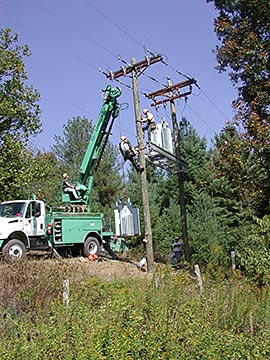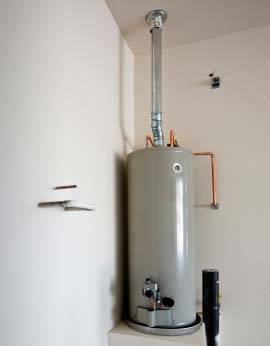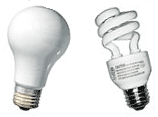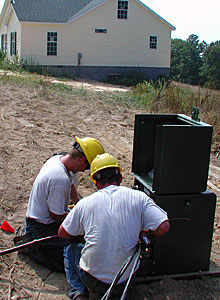Frequently Asked Question
- How do I protect my computer from momentary outages?
- What should I do when I experience power outages and power blinks?
- How do I check my home for energy efficiency?
- Where does the electrical energy get used?
- What about normal incandescent and the new fluorescent lights
- Can I get a tax break for installing energy efficient devices and windows?
- What is BARC’s service area?
- How do I become a member of BARC?
- Who reads my meter?
- Can I make advance payments to BARC?
How do I protect my computer from momentary outages?
Not many things are more frustrating than being half way through writing an email or being nearly finished with a paper for a school assignment and having your computer shut down due to a power blink or outage. There is an inexpensive way to protect your computer and to prevent loss of unsaved data due to a power outage.
An Uninterruptible Power Supply (UPS) is a device that shields the equipment connected to it from blinks or outages on the power lines. It has a battery that delivers enough power to absorb blinks and give you a few minutes to save your work and shut down your PC.
The UPS, in addition to providing protection against a complete power outage, provides protection against all common power problems, such as noise on the power line from other electronic or electrical appliances and voltage surges due to lightning and other causes.
While not limited to safeguarding any particular type of equipment, a UPS is typically used to protect computers, telecommunication equipment or other electrical equipment where an unexpected power disruption could cause serious business disruption or even just aggravation over data loss. UPS units come in sizes ranging from units which will back up a single computer without monitor (around 200 VA) to units which will power entire data centers or buildings (several megawatts). Larger UPS units for industrial or commercial purposes typically work in conjunction with generators.
UPS units for home or office use are available from retail electronics stores, major department stores, and office supply stores. A quick review of on-line prices suggests that a UPS for a typical home or small office computer system will range from $60.00 to $200.00 depending on size and the length of time you can run the computer without utility power. Please be aware that in most cases the UPS is not intended to run the computer for very long. They are typically designed to hold a load long enough for you to save your work and shut your computer off safely.
What should I do when I experience power outages and power blinks?

BARC strives to keep the power on 100% of the time, but, realistically speaking, 100% is not attainable. Mother Nature has many ways to interrupt our power. From major storms to squirrels chewing on transformer components, she can deliver a series of blinks or an extended outage at any time. And because BARC’s power lines are interconnected with the utilities around us, damage on their lines can impact our members. Losing power can be an aggravation or it can cause serious problems for businesses or members with medical equipment that requires an uninterrupted flow of power. If you fall into this serious problem category, we recommend purchasing a backup power supply either in the form of a battery device (see the FAQ on Uninterruptible Power Supplies (UPS) above) or an emergency generator.
Is there any way to eliminate blinks and outages entirely? The short answer there is, “No.” There are simply too many things that can make your lights blink or power go out. Many folks will ask why we do not put everything underground to avoid a lot of issues. The answer there is, “Cost. Cost and the fact that in many cases lines can’t be put underground because of rock and finding a fault in a buried line is a long and difficult process.” Your cooperate carefully engineers its system to make sure it provides the maximum level of reliability at the most affordable price.
One of the ways in which we engineer our system for reliability is with large circuit breakers. In the utility world they are called reclosers. When something hits the wire, the recloser sees a fault and trips, just like our circuit breakers at home. Unlike our breakers, the recloser waits a few seconds then closes back in, delivering power to the line. If the fault is still there, it opens again. If the fault remains after the third check, the device stays open. Blinks are bothersome but they prevent the power lines from experiencing serious damage that would create a much longer outage.
If you are experiencing blinks, please give us a call at 1.800.864.2272 and let us know. Blinks can be a sign of a problem in the making so this information lets us take preventive measures.
When you call, please have your account number handy. It can be found in the upper left corner of your bill. If you don’t have a bill close by then be sure you know whose name the account is listed in. While you are on the phone our Member Service Representative may ask for your 911 address to confirm that we have the correct phone number in the system.
How do I check my home for energy efficiency?
By using the BARC Energy Tools to run an analysis on your home. Start with the HomeEnergyCalculator to get an idea of where your energy dollars are going. Or, you can browse the many tools and specialty calculators we have made available. Of course, you can always contact us for an in-home energy audit.
Where does the electrical energy get used?

These devices typically use the most energy and offer the greatest savings potential when you are considering replacing standard equipment with equipment that is energy-efficient.
- Motors
- Electric Heat
- Electric Water Heater
- Air Conditioning
- Lighting
- Refrigerators and Freezers
- Electric ovens
- Exhaust Ventilation
- Supply Ventilation
- Game consoles – Yes, you read this correctly. A game console can consume as much electricity as a refrigerator! Be sure to turn them off completely when you’ve finished playing your games.
What about replacing incandescent bulbs with fluorescent or LED alternatives?
Lighting in a typical home can account for 20% of total electric use. So, using more efficient lamps and bulbs makes a lot of sense. Compact fluorescent lamps (CFL) have been around for over 20 years. Replacing an incandescent bulb with a CFL saves about 75% of the energy used and provides ;many other benefits. But before you tear off to retrofit your home or business with CFLs, consider the latest arrival, the light emitting diode (LED) bulb. These are about 22% more efficient than a CFL plus, in my opinion, look better than the corkscrew shape of a CFL. Yes, they cost more but if you put them in places that are hard top reach, you can forget about them for 10 years or more. Use the BARC Energy Tools Lighting Calculator to see how much you can save.
Can I get a tax break for installing energy-efficient devices and windows?

Often you can. Laws covering the equipment, products and appliances that qualify are changing all the time so be sure to confirm with your contractor or seller your eligibility for tax credits before buying or signing a contract. If you want to check for yourself, why not ask everyone’s favorite Federal agency, the IRS? If you prefer, check out this article and links from our land grant college friends at NCSU.
What is BARC’s service area?
BARC’s service area includes all of Bath County as well as portions of Highland, Alleghany Augusta, and Rockbridge Counties. Roughly half of our customers reside in Rockbridge County.
How do I become a member of BARC?
Before making a service connection, a $5.00 membership fee must be paid and an application for membership and electrical service must be completed. The membership fee is refundable after disconnection of electric service and after all final charges have been paid.
Who reads my meter?

WE DO! BARC Electric Cooperative was the first Cooperative in Virginia to complete the installation of Automatic Meter Reading (AMR) equipment throughout its service territory. This enables us to read your meter on a daily basis. This information is passed to our computer systems and your bill is calculated according to our cycle billing schedule. You will receive a monthly statement according to the week your cycle falls on.
Can I make advance payments to BARC?
Any person desiring to do so may make an advance payment with the Cooperative at any time. The monthly bills will continue to be rendered, showing the energy used for the period and the balance of the advance payment, or amount due, if any.
